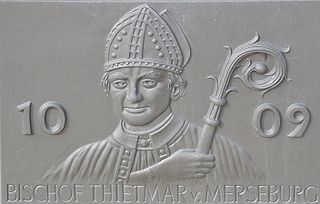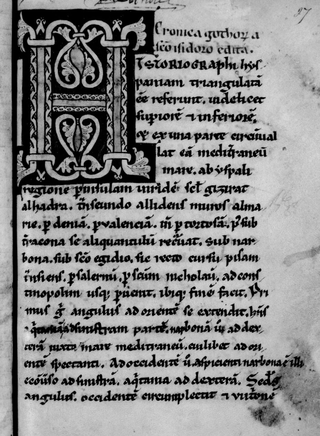Related Research Articles

Isidore of Seville was a Hispano-Roman scholar, theologian, and archbishop of Seville. He is widely regarded, in the words of 19th-century historian Montalembert, as "the last scholar of the ancient world".
Pope Agapetus I was the bishop of Rome from 13 May 535 to his death. His father, Gordianus, was a priest in Rome and he may have been related to two popes, Felix III and Gregory I.
The 560s decade ran from January 1, 560, to December 31, 569.

Year 549 (DXLIX) was a common year starting on Friday of the Julian calendar. The denomination 549 for this year has been used since the early medieval period, when the Anno Domini calendar era became the prevalent method in Europe for naming years.

Gelimer, King of the Vandals and Alans (530–534), was the last Germanic ruler of the North African Kingdom of the Vandals. He became ruler on 15 June 530 after deposing his first cousin twice removed, Hilderic, who had angered the Vandal nobility by converting to Chalcedonian Christianity, as most of the Vandals at this time were fiercely devoted to Arian Christianity.

The Second Council of Constantinople is the fifth of the first seven ecumenical councils recognized by both the Eastern Orthodox Church and the Catholic Church. It is also recognized by the Old Catholics and others. Protestant opinions and recognition of it are varied. Some Protestants, such as Calvinists, recognize the first four councils, whereas Lutherans and most Anglo-Catholics accept all seven. Constantinople II was convoked by the Byzantine Emperor Justinian I under the presidency of Patriarch Eutychius of Constantinople. It was held from 5 May to 2 June 553. Participants were overwhelmingly Eastern bishops—only sixteen Western bishops were present, including nine from Illyricum and seven from Africa, but none from Italy—out of the 152 total.
Pope Felix III was the bishop of Rome from 13 March 483 to his death. His repudiation of the Henotikon is considered the beginning of the Acacian schism. He is commemorated on March 1.
The Three-Chapter Controversy, a phase in the Chalcedonian controversy, was an attempt to reconcile the non-Chalcedonians of Syria and Egypt with Chalcedonian Christianity, following the failure of the Henotikon. The Three Chapters that Emperor Justinian I anathematized were:
- The person and writings of Theodore of Mopsuestia
- Certain writings of Theodoret of Cyrus
- The letter of Ibas of Edessa to Maris

Reccared I was Visigothic King of Hispania and Septimania. His reign marked a climactic shift in history, with the king's renunciation of Arianism in favour of Roman Christianity in 587.

Saint Hermenegild or Ermengild, was the son of king Liuvigild of the Visigothic Kingdom in the Iberian Peninsula and southern France. He fell out with his father in 579, then revolted the following year. During his rebellion, he converted from Arianism to Catholicism. Hermenegild was defeated in 584 and exiled. His death was later celebrated as a martyrdom due to the influence of Pope Gregory I's Dialogues, in which he portrayed Hermenegild as a "Catholic martyr rebelling against the tyranny of an Arian father."

The Third Council of Toledo (589) marks the entry of Visigothic Spain into the Catholic Church, and is known for codifying the filioque clause into Western Christianity. The council also enacted restrictions on Jews, and the conversion of the country to Catholic Christianity led to repeated conflict with the Jews.
John of Biclaro, Biclar, or Biclarum, also Iohannes Biclarensis, was a Visigoth chronicler. He was born in Lusitania, in the city of Scallabis. He was also bishop of Girona.

Liuva I 571–572, or 573) was a Visigothic King of Hispania and Septimania.

Witteric was the Visigoth King of Hispania, Septimania and Galicia. He ruled from 603 to 610.

Thietmar, Prince-Bishop of Merseburg from 1009 until his death, was an important chronicler recording the reigns of German kings and Holy Roman Emperors of the Ottonian (Saxon) dynasty. Two of Thietmar's great-grandfathers, both referred to as Liuthar, were the Saxon nobles Lothar II, Count of Stade, and Lothar I, Count of Walbeck. They were both killed fighting the Slavs at the Battle of Lenzen.

The Kingdom of the Suebi, also called the Kingdom of Galicia or Suebi Kingdom of Galicia, was a Germanic post-Roman kingdom that was one of the first to separate from the Roman Empire. Based in the former Roman provinces of Gallaecia and northern Lusitania, the de facto kingdom was established by the Suebi about 409, and during the 6th century it became a formally declared kingdom identifying with Gallaecia. It maintained its independence until 585, when it was annexed by the Visigoths, and was turned into the sixth province of the Visigothic Kingdom in Hispania.

Saint Eugenius of Carthage was a Christian saint, unanimously elected Bishop of Carthage in 480 to succeed Deogratias. He was caught up in the disputes of his day between Arianism and mainstream Christianity.
The Historia de regibus Gothorum, Vandalorum et Suevorum is a Latin history of the Goths from 265 to 624, written by Isidore of Seville. It is a condensed account and, due to its diverse sources, somewhat inconsistent. The history of the Vandals is appended after that of the Goths, followed by a separate history of the Suevi.

The Vandal Kingdom or Kingdom of the Vandals and Alans was a confederation of Vandals and Alans, which is one of the barbarian kingdoms established under Gaiseric, a Vandal warrior. It ruled in North Africa and the Mediterranean from 435 to 534 AD.

The Chronica Gothorum Pseudoisidoriana, also known as the Historia Pseudoisidoriana or the Chronicle of Pseudo-Isidore, is an anonymous 12th-century Latin chronicle from southern France. It presents the history of Spain from the time of the sons of Noah and their dispersal down to the Arab conquest in 711.
References
- ↑ Herrin, Judith (1989). The Formation of Christendom. Princeton University Press. p. 241. ISBN 0-691-00831-0 . Retrieved Sep 20, 2014.
- 1 2 3 4 Conquerors and Chroniclers of Early Medieval Spain. Translated by Kenneth Baxter Wolf. Liverpool University Press. 1999. pp. 2, 5, 48, 57. ISBN 0-85323-554-6 . Retrieved Sep 20, 2014.
- 1 2 The Catholic Encyclopedia: Volume Fifteen: An International Work of Reference On The Constitution, Doctrine, Discipline, And History Of The Catholic Church. The Encyclopedia Press, INC. 1912. p. 412. Retrieved Sep 20, 2014.
- ↑ English (2004). "Isidore of Seville, Chronicon". Early Church Fathers. Translated by Kenneth B. Wolf . Retrieved Sep 20, 2014.
- ↑ Ott, Michael (1912). "Victor". New Advent .
- ↑ Martyn, John R. C. (2020). Arians and Vandals of the 4th-6th Centuries: Annotated translations of the historical works by Bishops Victor of Vita and Victor of Tonnena, and of the religious works by Bishop Victor of Cartenna and Saints Ambrose, and Athanasius. Cambridge Scholars Publishing. pp. 130–132. ISBN 9781527563766.